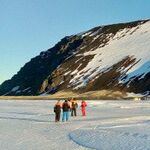|
Chegaram ao fim dois meses intensos de trabalho no laboratório! Este projeto teve como objetivo a ida para o British Antarctic Survey (Cambridge, Reino Unido) analisar conteúdos estomacais de predadores de topo para compreender melhor o papel dos cefalópodes na cadeia alimentar do Oceano Austral. Durante os últimos dois meses abrimos mais de 1000 estômagos de Bacalhau da Antártida (Dissostichus mawsoni) e da Patagonia (D. eleginoides) que foram recolhidos em 2020 na Georgia do Sul e Ilhas Sandwich do Sul (sector Atlântico do Oceano Austral). Além de funcionarem como amostradores biológicos de cefalópodes na região, estudar a dieta destas duas espécies de peixes permite-nos entender o funcionamento das cadeias alimentares de mar profundo do Oceano Austral mas também, sendo estas duas espécies comercializadas, perceber como a captura destes organismos pode alterar as estrutura da comunidade e como podemos melhorar a gestão dos recursos. A rotina realizada durante este projeto foi praticamente sempre igual, das 8h da manhã até às 17:30h (devido a regras do instituto não podemos permanecer nos laboratórios após esta hora) sempre a abrir estômagos. A única pausa do trabalho foi quando, já na parte final, testei positivo à covid e tive de ficar por casa a trabalhar ao computador! Trabalhar com estômagos de bacalhau tem a vantagem de conseguirmos obter amostras de grandes lulas, mas a desvantagem de deixar um cheiro a peixe (por vezes a fugir para o “estragado”) no laboratório que ninguém conseguiu trabalhar lá enquanto eu trabalhava. Nos mais de 1000 estômagos de Bacalhau, conseguimos encontrar amostras de lula colossal (Mesonychoteuthis hamiltoni), o invertebrado mais pesado do planeta com cerca de 500 Kg, mas também alguns indivíduos inteiros de lulas mais pequenas. Tendo em conta a pouca seletividade dos nossos predadores, além das lulas ainda pudemos identificar peixes, crustáceos (camarões e caranguejos) e ... um pinguim (não mostro fotos porque já não era um pinguim fofo)!!! A maioria dos tecidos recolhidos, de presas e predadores, já se encontra em Portugal à espera de ser analisada quimicamente. Por exemplo, usando isótopos estáveis iremos determinar os níveis tróficos das diferentes espécies. Além das análises químicas, o estudo do conteúdo estomacal de mais de 1000 estômagos de bacalhau irá permitir fazer a maior descrição da dieta destes predadores de sempre. Para terminar, gostaria só de fazer um agradecimento especial ao Paul Geissler, o gestor de laboratórios do BAS, por toda a disponibilidade quando precisávamos de algo e por todo o esforço feito em tratar todo o “desperdício” (solido e líquido) que fizemos e, por razões de biossegurança, teve de ser submetido a um tratamento especial. It came to an end two months of intensive laboratory work! The main goal of this project was to go to the British Antarctic Survey (Cambridge, United Kingdom) to analyse stomach contents of Antarctic top predators to better understand the role of cephalopods in the Southern Ocean food web.
0 Comentários
|
DIÁRIOS DE CAMPANHA
|

 Feed RSS
Feed RSS
